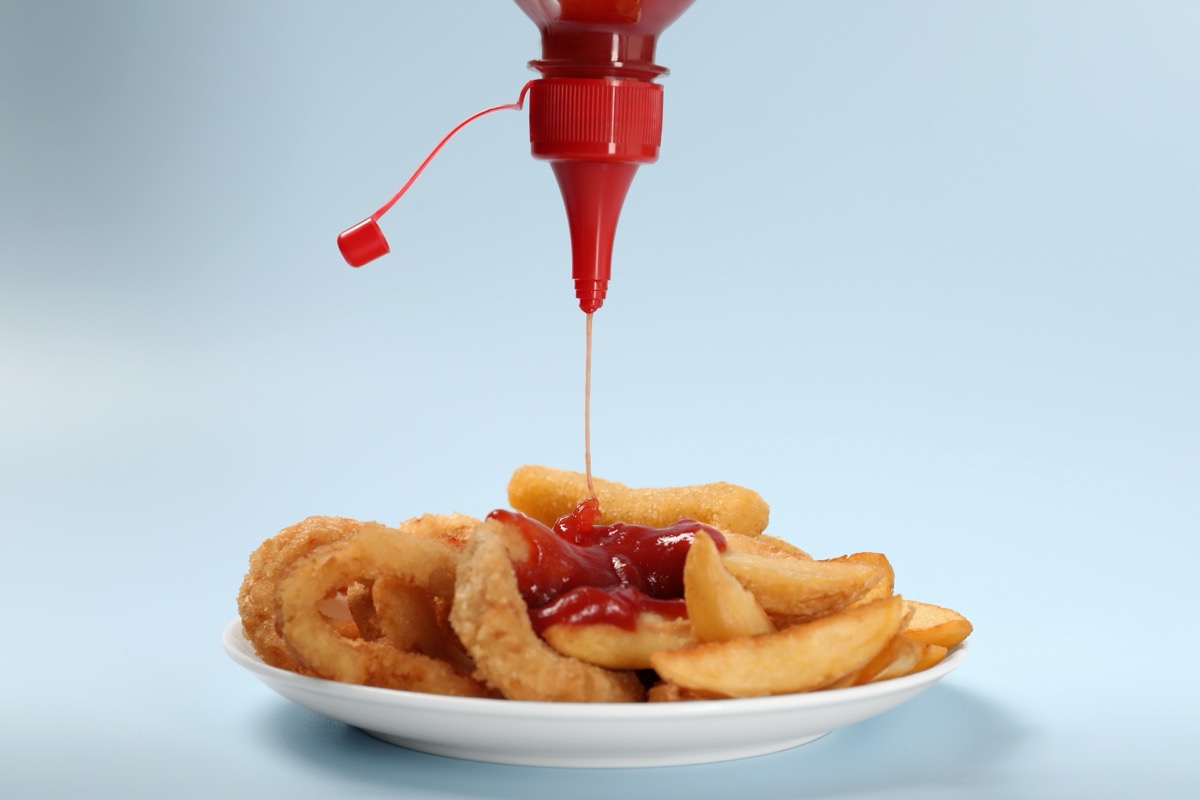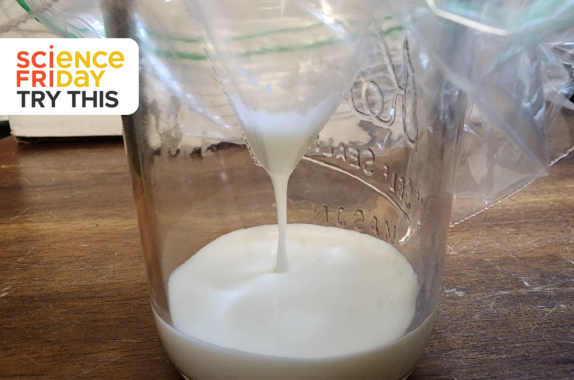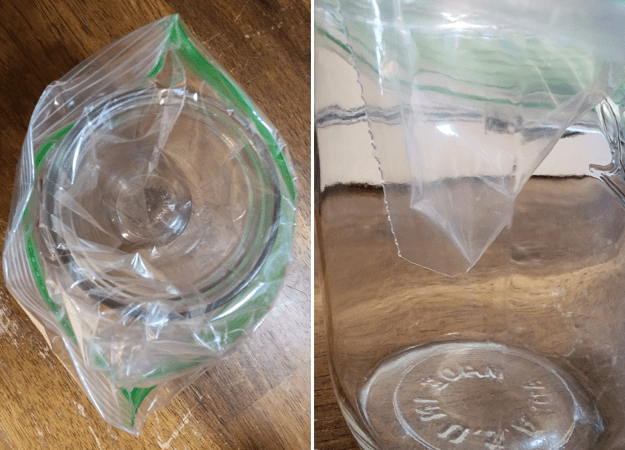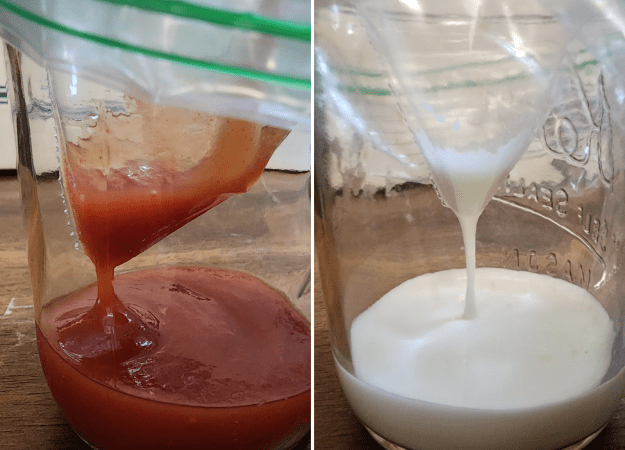Grade Level
All
minutes
15 min - 1 hr
subject
Physical Science
stem practices
Planning and Carrying Out Investigations
Activity Type:
Family activity, kitchen chemistry, food science
If you’ve ever whacked the bottom of a ketchup bottle to get that tasty tomato goop flowing, you’ve put some serious physics to work. Ketchup is a non-Newtonian fluid. So are toothpaste, yogurt, shampoo, Silly Putty, and paint. They all change how they flow when under stress.

Fluids And Viscosity
You may have heard of the states of matter and learned about solids, liquids, and gasses. Liquids and gasses are fluids, which flow and take the shape of their container. Fluids have viscosity. This property refers to how much a fluid resists flowing. Water flows more easily than honey, for example, because it has less viscosity. Viscosity is affected by temperature. So if you warm honey up, it will flow more easily.
In the case of non-Newtonian fluids, the viscosity also changes based on the force applied to it. Forces are pushes or pulls: Stirring a fluid applies a force on the fluid as you push it with the spoon. This kind of force is called a shear force or shear stress. It makes one part of the fluid slide past other parts.
Some non-Newtonian fluids will thicken—increase viscosity—when a shear stress is applied, as in stirring. This is called shear-thickening. Others get less viscous, which is called shear-thinning. But you don’t have to take our word for it. Let’s test this!

Testing Viscosity Under Stress
The most famous non-Newtonian fluid is probably Oobleck, a mixture of cornstarch and water. In this experiment, you will compare it to a lesser-known non-Newtonian fluid: ketchup. Tomato ketchup is a mixture of tomato paste, vinegar, sugar, and spices. It may not sound like it has much in common with Oobleck, but both react to shear stresses.
Materials
- Ketchup (bottled or packets)
- Corn starch
- Water
- Measuring spoons
- Two coffee stirrers, popsicle sticks, or similar items
- Two plastic sandwich bags
- Two clear cups or jars
- Two bowls or additional cups
- Scissors
Substitute Options: If you don’t have ketchup, try yogurt, mayonnaise, or mustard. No corn starch? Substitute tapioca, arrowroot, potato starch, or baking soda. Note that flour will not work.
In this experiment, you’ll observe the flow of Oobleck and ketchup through a funnel. You will stir each to see how applying shear stress affects the flow of the fluids. You may want a partner to help you make observations.
Procedure:
- Hold your plastic bags together so that their bottom corners match up. Choose one side of the bags and use scissors to snip the corners off about ⅛ of an inch (3 mm) from the point. Cut both bags simultaneously so the hole is roughly the same size on each bag. This will create a small hole in each bag for your funnels. Ideally, we want the fluids to drip steadily from the funnels.
- Open one bag. Place the cut tip into the center of one of the clear cups or jars. Pull the open top of the bag over the edge of the cup to create a funnel, with the tip of the bag a few inches from the bottom. You may want to roll the edge of the bag towards the top edge of the cup, so you can see inside more easily.
- Repeat with the second bag and cup. Set both aside.
- Create your Oobleck mixture: In a cup or bowl, add 2 tablespoons of cornstarch and 1 tablespoon of water. Mix well.
- Prepare your ketchup: In another cup or bowl, add 2 tablespoons of ketchup and 1 tablespoon of water. Mix well. We are thinning the ketchup to make it easier to see any changes in the flow.
- Retrieve the first funnel and cup. Pour the ketchup mixture into the funnel. Be ready to observe immediately. After some of the ketchup has flowed through the funnel, use your popsicle stick to stir the mixture in the funnel. Then stop stirring. Look for changes in the flow while stirring. Does it flow faster or slower? Does the stream of fluid look thinner or thicker?
- Retrieve your second funnel and cup. Repeat the experiment above with your Oobleck mixture. Look for changes in the flow while stirring. Does it flow faster or slower? Does the stream of fluid look thinner or thicker?
- If needed, repeat the experiment. You can use the fluids several times. You can also make more of each fluid. Just keep a 2-to-1 ratio of sample to water.
Think about what you’ve observed. Ask yourself these questions:
- Did you see any differences in flow while stirring compared to not stirring? Did the viscosity increase or decrease?
- Did you see any differences in the effect of stirring on the flow of Oobleck compared to ketchup?
- Would you characterize either as shear-thinning or shear-thickening? Shear-thinning fluids flow more easily when shaken or stirred. Shear-thickening fluids behave in the opposite way.
- Can you think of any advantages or disadvantages these changes in viscosity may have for foods or other materials? (Think: Why might hitting or shaking a ketchup bottle be so helpful in getting the ketchup out?)
Want to keep exploring viscosity in non-Newtonian fluids? Grab some mayo, mustard, or yogurt, and repeat the experiment above. You may want to try a control as well, such as water. Try changing the ratio of sample to water to see how that affects the response to shear stress. Or test how cooling or warming the samples affects viscosity. What experiment can you design to understand more about non-Newtonian fluids?
We want to hear about what you discover. Send us a note at educate@sciencefriday.com. If you share pictures or videos on social media, be sure to tag us with @scifri.
Why Do Non-Newtonian Fluids Behave This Way?
That’s a great question! Scientists have debated what causes shear-thinning and shear-thickening since the time of Sir Isaac Newton, who first described the property of viscosity in 1687. And the truth is, they’re not precisely sure … yet.
However, recent research indicates that the key to Oobleck’s stress-thickening behavior may be the result of friction. Scientists added piezoelectric nanoparticles to a non-Newtonian fluid, causing it to generate an electric charge when friction is applied. Then, they applied shear stress and measured the viscosity changes and the electrical signals generated. The researchers discovered a direct link between the friction between the particles in the fluid and the change in viscosity. Basically, under enough stress, the particles of the fluid rub against one another, causing a change in viscosity. It’s a bit like having too many people trying to walk through a door at the same time.
The scientists hope to use this information to engineer new non-Newtonian fluids. They may invent paints that don’t clump, concrete that instantly hardens when shaken, or protective gear that gets stiffer when it hits a surface.
The Oozy Physics Of Oobleck
Keep Learning
Are you fascinated by non-Newtonian fluids? You’re not alone! Try these resources to learn more.
- Learn more about the research and physics of non-Newtonian fluids in The Oozy Physics Of Oobleck.
- This activity was based on an experiment from PhysicsQuest by the American Physical Society. Read their graphic novel featuring Spectra, a high school superhero who uses her physics knowledge to thwart villains!
- Many non-Newtonian fluids are also colloids—a mixture in which tiny particles of one material are scattered uniformly through another material. Learn more about these mixtures and make butter!
- See how Oobleck responds to the vibrations of a speaker.
- Slime is also a non-Newtonian fluid. Try making your own!
Credits
Lesson by Sandy Roberts
Copyediting by Lois Parshley
Digital Production by Sandy Roberts
Meet the Writer
About Sandy Roberts
Sandy Roberts is Science Friday’s Education Program Manager, where she creates learning resources and experiences to advance STEM equity in all learning environments. Lately, she’s been playing with origami circuits and trying to perfect a gluten-free sourdough recipe.


